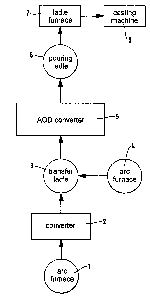Some of the information on this Web page has been provided by external sources. The Government of Canada is not responsible for the accuracy, reliability or currency of the information supplied by external sources. Users wishing to rely upon this information should consult directly with the source of the information. Content provided by external sources is not subject to official languages, privacy and accessibility requirements.
Any discrepancies in the text and image of the Claims and Abstract are due to differing posting times. Text of the Claims and Abstract are posted:
| (12) Patent: | (11) CA 2133918 |
|---|---|
| (54) English Title: | METHOD AND DEVICE FOR PRODUCING STAINLESS STEEL |
| (54) French Title: | METHODE ET DISPOSITIF SERVANT A PRODUIRE DE L'ACIER INOXYDABLE |
| Status: | Term Expired - Post Grant Beyond Limit |
| (51) International Patent Classification (IPC): |
|
|---|---|
| (72) Inventors : |
|
| (73) Owners : |
|
| (71) Applicants : |
|
| (74) Agent: | NORTON ROSE FULBRIGHT CANADA LLP/S.E.N.C.R.L., S.R.L. |
| (74) Associate agent: | |
| (45) Issued: | 2002-02-12 |
| (22) Filed Date: | 1994-10-20 |
| (41) Open to Public Inspection: | 1995-04-26 |
| Examination requested: | 1997-11-05 |
| Availability of licence: | N/A |
| Dedicated to the Public: | N/A |
| (25) Language of filing: | English |
| Patent Cooperation Treaty (PCT): | No |
|---|
| (30) Application Priority Data: | ||||||
|---|---|---|---|---|---|---|
|
The invention relates to a method and device for producing stainless steel, comprising methods for creating a ferro- alloy, such as ferrochromium, and for further processing the alloy in order to produce a desired stainless steel. According to the invention, the melt obtained from the ferro- alloy production unit (1) is transferred at least partly to a ferroalloy processing unit (2) arranged in between the ferroalloy production unit (1) and the stainless steel production unit (5); in the said processing unit (2), the composition of the ferroalloy is adjusted to be suitable for the production of stainless steel.
La présente invention concerne un procédé et un dispositif pour la production de l'acier inoxydable, comprenant des procédés de fabrication d'un ferro-alliage, tel que le ferrochrome, et pour le traitement ultérieur de l'alliage afin de produire un acier inoxydable souhaité. Selon l'invention, la masse fondue obtenue à partir de l'unité de production de ferro-alliages (1) est transférée au moins en partie à une unité de traitement de ferro-alliages (2) disposée entre l'unité de production de ferro-alliages (1) et l'unité de production d'acier inoxydable (5); dans ladite unité de traitement (2), la composition du ferro-alliage est ajustée pour convenir à la production de l'acier inoxydable.
Note: Claims are shown in the official language in which they were submitted.
Note: Descriptions are shown in the official language in which they were submitted.

2024-08-01:As part of the Next Generation Patents (NGP) transition, the Canadian Patents Database (CPD) now contains a more detailed Event History, which replicates the Event Log of our new back-office solution.
Please note that "Inactive:" events refers to events no longer in use in our new back-office solution.
For a clearer understanding of the status of the application/patent presented on this page, the site Disclaimer , as well as the definitions for Patent , Event History , Maintenance Fee and Payment History should be consulted.
| Description | Date |
|---|---|
| Inactive: Expired (new Act pat) | 2014-10-20 |
| Inactive: IPC from MCD | 2006-03-11 |
| Inactive: IPC from MCD | 2006-03-11 |
| Inactive: IPC from MCD | 2006-03-11 |
| Grant by Issuance | 2002-02-12 |
| Inactive: Cover page published | 2002-02-11 |
| Pre-grant | 2001-11-20 |
| Inactive: Final fee received | 2001-11-20 |
| Notice of Allowance is Issued | 2001-10-19 |
| Notice of Allowance is Issued | 2001-10-19 |
| 4 | 2001-10-19 |
| Letter Sent | 2001-10-19 |
| Inactive: Approved for allowance (AFA) | 2001-09-21 |
| Amendment Received - Voluntary Amendment | 2001-08-20 |
| Inactive: S.30(2) Rules - Examiner requisition | 2001-03-07 |
| Inactive: First IPC assigned | 2000-07-13 |
| Inactive: RFE acknowledged - Prior art enquiry | 1997-11-28 |
| Inactive: Application prosecuted on TS as of Log entry date | 1997-11-26 |
| Inactive: Status info is complete as of Log entry date | 1997-11-26 |
| Request for Examination Requirements Determined Compliant | 1997-11-05 |
| All Requirements for Examination Determined Compliant | 1997-11-05 |
| Application Published (Open to Public Inspection) | 1995-04-26 |
There is no abandonment history.
The last payment was received on 2001-10-04
Note : If the full payment has not been received on or before the date indicated, a further fee may be required which may be one of the following
Patent fees are adjusted on the 1st of January every year. The amounts above are the current amounts if received by December 31 of the current year.
Please refer to the CIPO
Patent Fees
web page to see all current fee amounts.
Note: Records showing the ownership history in alphabetical order.
| Current Owners on Record |
|---|
| OUTOKUMPU STEEL OY |
| Past Owners on Record |
|---|
| EERO RATTYA |
| JORMA KEMPPAINEN |
| MATTI HONKANIEMI |
| RISTO PELLIKKA |
| VEIKKO JUNTUNEN |